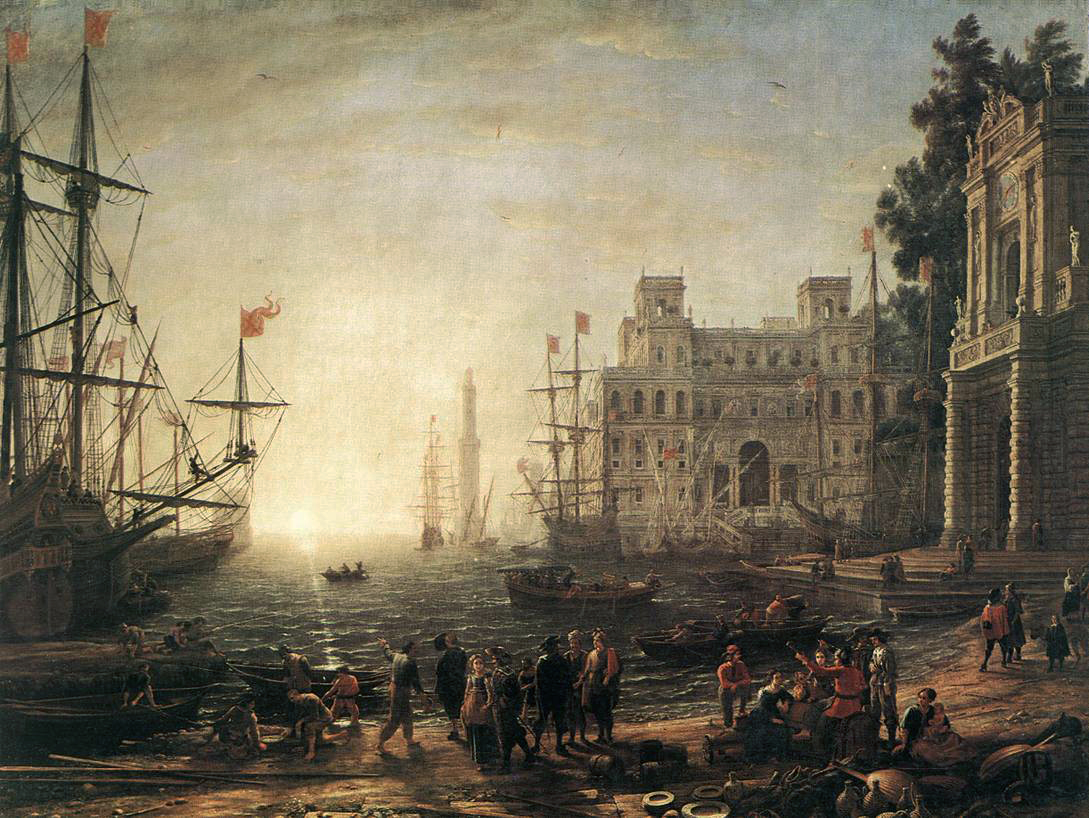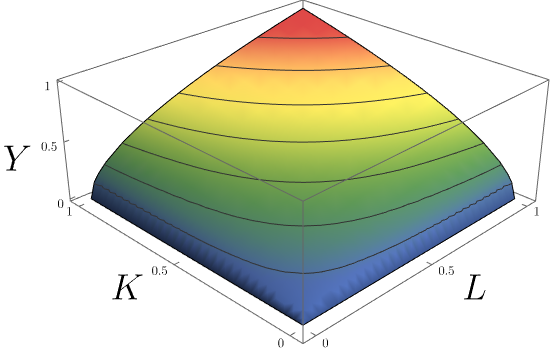|
Leontief Production Function
In economics, the Leontief production function or fixed proportions production function is a production function that implies the factors of production which will be used in fixed (technologically predetermined) proportions, as there is no substitutability between factors. It was named after Wassily Leontief and represents a limiting case of the constant elasticity of substitution production function. For the simple case of a good that is produced with two inputs, the function is of the form :q = \text\left(\frac,\frac\right) where ''q'' is the quantity of output produced, ''z''1 and ''z''2 are the utilised quantities of input 1 and input 2 respectively, and ''a'' and ''b'' are technologically determined constants. Example Suppose that the intermediate goods "tires" and "steering wheels" are used in the production of automobiles (for simplicity of the example, to the exclusion of anything else). Then in the above formula ''q'' refers to the number of automobiles produced, ''z ... [...More Info...] [...Related Items...] OR: [Wikipedia] [Google] [Baidu] |
Leontief
Wassily Wassilyevich Leontief (; August 5, 1905 – February 5, 1999) was a Soviet-American economist known for his research on input–output analysis and how changes in one economic sector may affect other sectors. Leontief won the Nobel Memorial Prize in Economic Sciences in 1973, and four of his doctoral students have also been awarded the prize (Paul Samuelson 1970, Robert Solow 1987, Vernon L. Smith 2002, Thomas Schelling 2005). Biography Early life Wassily Leontief was born on August 5, 1905, in Munich, German Empire, the son of Wassily W. Leontief (professor of Economics) and Zlata (German spelling ''Slata''; later Evgenia) Leontief (née Becker). Wassily Leontief Sr. belonged to a family of Russian old-believer merchants living in St. Petersburg since 1741. Evgenia (Genya) Becker belonged to a wealthy Jewish family from Odessa. At 15 in 1921, Wassily Jr. entered Petrograd State University in present-day St. Petersburg. He earned his Learned Economist degree (equiv ... [...More Info...] [...Related Items...] OR: [Wikipedia] [Google] [Baidu] |
Economics
Economics () is a behavioral science that studies the Production (economics), production, distribution (economics), distribution, and Consumption (economics), consumption of goods and services. Economics focuses on the behaviour and interactions of Agent (economics), economic agents and how economy, economies work. Microeconomics analyses what is viewed as basic elements within economy, economies, including individual agents and market (economics), markets, their interactions, and the outcomes of interactions. Individual agents may include, for example, households, firms, buyers, and sellers. Macroeconomics analyses economies as systems where production, distribution, consumption, savings, and Expenditure, investment expenditure interact; and the factors of production affecting them, such as: Labour (human activity), labour, Capital (economics), capital, Land (economics), land, and Entrepreneurship, enterprise, inflation, economic growth, and public policies that impact gloss ... [...More Info...] [...Related Items...] OR: [Wikipedia] [Google] [Baidu] |
Production Function
In economics, a production function gives the technological relation between quantities of physical inputs and quantities of output of goods. The production function is one of the key concepts of mainstream economics, mainstream neoclassical economics, neoclassical theories, used to define marginal product and to distinguish allocative efficiency, a key focus of economics. One important purpose of the production function is to address allocative efficiency in the use of factor inputs in production and the resulting distribution of income to those factors, while abstracting away from the technological problems of achieving technical efficiency, as an engineer or professional manager might understand it. For modelling the case of many outputs and many inputs, researchers often use the so-called Shephard's distance functions or, alternatively, directional distance functions, which are generalizations of the simple production function in economics. In macroeconomics, aggregate produc ... [...More Info...] [...Related Items...] OR: [Wikipedia] [Google] [Baidu] |
Factors Of Production
In economics, factors of production, resources, or inputs are what is used in the production process to produce output—that is, goods and services. The utilised amounts of the various inputs determine the quantity of output according to the relationship called the production function. There are four ''basic'' resources or factors of production: land, labour, capital and entrepreneur (or enterprise). The factors are also frequently labeled "producer goods or services" to distinguish them from the goods or services purchased by consumers, which are frequently labeled "consumer goods". There are two types of factors: ''primary'' and ''secondary''. The previously mentioned primary factors are land, labour and capital. Materials and energy are considered secondary factors in classical economics because they are obtained from land, labour, and capital. The primary factors facilitate production but neither become part of the product (as with raw materials) nor become significantly tran ... [...More Info...] [...Related Items...] OR: [Wikipedia] [Google] [Baidu] |
Substitute Good
In microeconomics, substitute goods are two goods that can be used for the same purpose by consumers. That is, a consumer perceives both goods as similar or comparable, so that having more of one good causes the consumer to desire less of the other good. Contrary to complementary goods and independent goods, substitute goods may replace each other in use due to changing economic conditions. An example of substitute goods is Coca-Cola and Pepsi; the interchangeable aspect of these goods is due to the similarity of the purpose they serve, i.e. fulfilling customers' desire for a soft drink. These types of substitutes can be referred to as close substitutes. Substitute goods are commodity which the consumer demanded to be used in place of another good. Economic theory describes two goods as being close substitutes if three conditions hold: # products have the same or similar performance characteristics # products have the same or similar occasion for use and # products are sold in th ... [...More Info...] [...Related Items...] OR: [Wikipedia] [Google] [Baidu] |
Wassily Leontief
Wassily Wassilyevich Leontief (; August 5, 1905 – February 5, 1999) was a Soviet-American economist known for his research on input–output analysis and how changes in one economic sector may affect other sectors. Leontief won the Nobel Memorial Prize in Economic Sciences in 1973, and four of his doctoral students have also been awarded the prize (Paul Samuelson 1970, Robert Solow 1987, Vernon L. Smith 2002, Thomas Schelling 2005). Biography Early life Wassily Leontief was born on August 5, 1905, in Munich, German Empire, the son of Wassily W. Leontief (professor of Economics) and Zlata (German spelling ''Slata''; later Evgenia) Leontief (née Becker). Wassily Leontief Sr. belonged to a family of Russian old-believer merchants living in St. Petersburg since 1741. Evgenia (Genya) Becker belonged to a wealthy Jewish family from Odessa. At 15 in 1921, Wassily Jr. entered Petrograd State University in present-day St. Petersburg. He earned his Learned Economist degree (equiv ... [...More Info...] [...Related Items...] OR: [Wikipedia] [Google] [Baidu] |
Limiting Case (mathematics)
In mathematics, a limiting case of a mathematical object is a special case that arises when one or more components of the object take on their most extreme possible values. For example: * In statistics, the limiting case of the binomial distribution is the Poisson distribution. As the number of events tends to infinity in the binomial distribution, the random variable changes from the binomial to the Poisson distribution. *A circle is a limiting case of various other figures, including the Cartesian oval, the ellipse, the superellipse, and the Cassini oval. Each type of figure is a circle for certain values of the defining parameters, and the generic figure appears more like a circle as the limiting values are approached. *Archimedes calculated an approximate value of π by treating the circle as the limiting case of a regular polygon with 3 × 2''n'' sides, as ''n'' gets large. *In electricity and magnetism, the long wavelength limit is the limiting case when the wave ... [...More Info...] [...Related Items...] OR: [Wikipedia] [Google] [Baidu] |
Constant Elasticity Of Substitution
Constant elasticity of substitution (CES) is a common specification of many production functions and utility function In economics, utility is a measure of a certain person's satisfaction from a certain state of the world. Over time, the term has been used with at least two meanings. * In a Normative economics, normative context, utility refers to a goal or ob ...s in neoclassical economics. CES holds that the ability to substitute one input factor with another (for example labour with capital) to maintain the same level of production stays constant over different production levels. For utility functions, CES means the consumer has constant preferences of how they would like to substitute different goods (for example labour with consumption) while keeping the same level of utility, for all levels of utility. What this means is that both producers and consumers have similar input structures and preferences no matter the level of output or utility. The vital economic element o ... [...More Info...] [...Related Items...] OR: [Wikipedia] [Google] [Baidu] |
Cobb–Douglas Production Function
In economics and econometrics, the Cobb–Douglas production function is a particular functional form of the production function, widely used to represent the technological relationship between the amounts of two or more inputs (particularly physical capital and labor) and the amount of output that can be produced by those inputs. The Cobb–Douglas form was developed and tested against statistical evidence by Charles Cobb and Paul Douglas between 1927 and 1947; according to Douglas, the functional form itself was developed earlier by Philip Wicksteed. Formulation In its most standard form for production of a single good with two factors, the function is given by: : Y(L,K)=AL^\beta K^\alpha where: * ''Y'' = total production (the real value of all goods produced in a year or 365.25 days) * ''L'' = labour input (person-hours worked in a year or 365.25 days) * ''K'' = capital input (a measure of all machinery, equipment, and buildings; the value of capital input divided by t ... [...More Info...] [...Related Items...] OR: [Wikipedia] [Google] [Baidu] |
Isoquant
An isoquant (derived from ''quantity'' and the Greek word ', , meaning "equal"), in microeconomics, is a contour line drawn through the set of points at which the same quantity of output is produced while changing the quantities of two or more inputs. The x and y axis on an isoquant represent two relevant inputs, which are usually a factor of production such as labour, capital, land, or organisation. An isoquant may also be known as an "iso-product curve", or an "equal product curve". Vs. indifference curves While an indifference curve mapping helps to solve the utility-maximizing problem of consumers, the isoquant mapping deals with the cost-minimization and profit and output maximisation problem of producers. Indifference curves further differ to isoquants, in that they cannot offer a precise measurement of utility, only how it is relevant to a baseline. Whereas, from an isoquant, the product can be measured accurately in physical units, and it is known by exactly how much iso ... [...More Info...] [...Related Items...] OR: [Wikipedia] [Google] [Baidu] |



